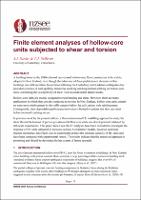| dc.description.abstract | A building boom in the 1980s allowed pre-stressed hollow-core floor construction to be widely adopted in New Zealand, even though the behaviour of these prefabricated elements within buildings was still uncertain. Inspections following the Canterbury and Kaikōura earthquakes has provided evidence of web-splitting, transverse cracking and longitudinal splitting on hollow-core units, confirming the susceptibility of these floors to undesirable failure modes.
Hollow-core slabs are mainly designed to resist bending and shear. However, there are many applications in which they are also subjected to torsion. In New Zealand, hollow-core units contain no transverse reinforcement in the soffit concrete below the cells and no web reinforcement. Consequently, their dependable performance in torsion is limited to actions that they can resist before torsional cracking occurs.
In previous work by the present authors, a three-dimensional FE modelling approach to study the shear flexural behaviour of precast pre-stressed hollow core units was developed and validated by full-scale experiments. This paper shows how the FE analyses have been extended to investigate the response of HC units subjected to torsional actions. Constitutive models, based on nonlinear fracture mechanics, have been used to numerically predict the torsional capacity of HC units and have been compared with experimental results. The results indicate that the numerical approach is promising and should be developed further as part of future research. | |

